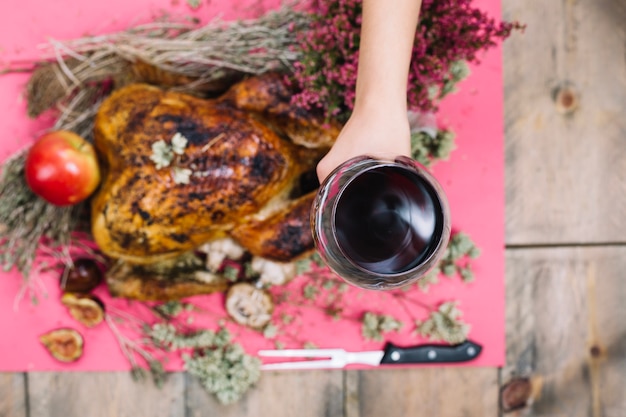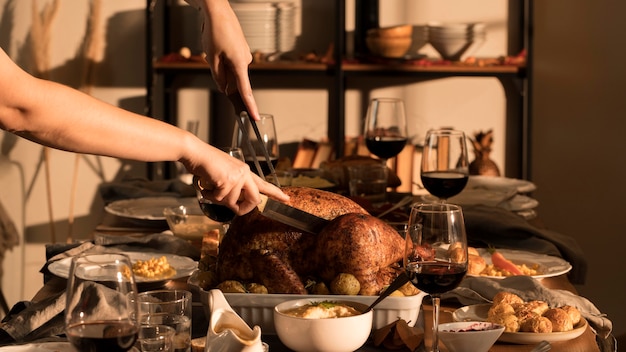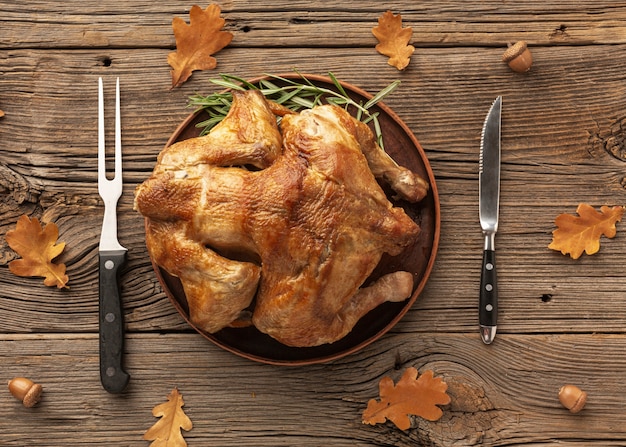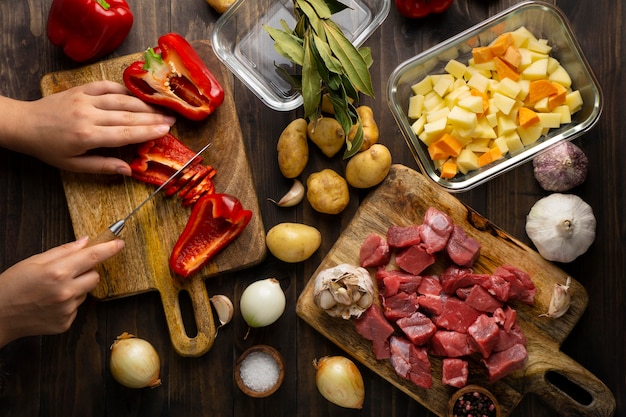Ah, the humble turkey. A Thanksgiving staple, a Christmas centrepiece, and a delicious dinner for any occasion. I've roasted countless turkeys over the years, and I've learned a thing or two about getting that perfect golden-brown bird, juicy and flavorful, ready to grace your table. It can seem daunting, all those brines, baste, and timing. But don't worry, I'm here to guide you through it, sharing my tried-and-true tips and tricks, along with some delectable recipes. So, grab your apron, preheat your oven, and let's get cooking!
Part 1: Choosing the perfect turkey

Fresh vs Frozen: The Great Turkey Debate
First things first, you need to decide whether you're going fresh or frozen. Fresh turkeys tend to have a more intense flavour and a juicier texture, but they're also generally more expensive and need to be cooked within a few days. frozen turkeys are convenient, can be stored for longer, and are often more affordable. They do require more thawing time, though, and you might find the flavour a bit less vibrant. Personally, I usually go for fresh, but I know lots of people who swear by frozen for their ease of use. Ultimately, it's up to you and what suits your needs best.
Size Matters: How Big a Bird Do You Need?
Once you've chosen your turkey type, it's time to think about size. You don't want to end up with a tiny bird for a big crowd, or a mountain of leftovers that won't fit in your fridge! A good rule of thumb is to allow about 1 pound of turkey per person. But remember, if you're serving lots of sides, you can always go for a slightly smaller bird. And let's be honest, who doesn't love leftover turkey sandwiches?
Part 2: Prepping for a Delicious Roast: Getting Your Turkey Ready

Brining: The Secret to a Juicy Bird
Now, let's talk about brining. This is where things get really interesting. Brining is the key to a juicy, flavorful turkey. It's basically a simple soaking process in a saltwater solution that helps the turkey retain moisture and develop a more intense flavor. I always brine my turkey, and I've never looked back. It's a bit of extra work, but trust me, it's worth it!
The Brining Solution: A simple recipe
Here's a basic brining recipe you can use:
- 1 gallon of cold water
- 1 cup kosher salt
- 1/2 cup sugar
- 1/4 cup black peppercorns
- 2 bay leaves
- 1 tablespoon dried thyme
- 1 tablespoon dried rosemary
Just mix all the ingredients together in a large container, large enough to hold your turkey. Submerge the turkey in the brine, making sure it's completely covered, and refrigerate for at least 4 hours, or even better, overnight. You can also find pre-made brining bags in most supermarkets, which make the process even easier.
Beyond the Basics: Flavourful Brining Options
If you're feeling adventurous, there are endless ways to customize your brining solution. You can add citrus fruits like oranges or lemons for a refreshing twist, or try adding spices like garlic, ginger, or chili flakes for a bolder flavor. Experiment and see what works best for you! Just remember to adjust the amount of salt accordingly, as adding other ingredients can affect the overall saltiness of the brine.
Removing the Giblets: A Vital Step You Can't Skip
Once your turkey is thawed and brined, it's time to remove the giblets. These are usually packed inside the turkey cavity, along with the neck. Don't toss them out! You can use them to make a delicious gravy or even a flavorful stuffing. Just give them a good rinse before using them in your recipes.
Part 3: Setting the Stage for Roasting: Getting Everything Ready

Stuffing: A Classic (and Sometimes Controversial) Side
Now, let's talk about stuffing. This is a bit of a controversial topic in the turkey world. Some people swear by stuffing their turkey, while others prefer to cook it separately in a casserole dish. The main concern with stuffing the turkey is that it might not cook evenly, potentially leading to food safety issues. If you're going to stuff your turkey, be sure not to pack it too tightly, and check the internal temperature of the stuffing to ensure it reaches a safe 165°F (74°C). Personally, I tend to cook my stuffing separately, just to be on the safe side and ensure it cooks thoroughly.
Preheating the Oven: The Foundation of Even Cooking
Get your oven preheated to 325°F (160°C). This is a crucial step for achieving a perfectly cooked turkey. A cold oven will take longer to cook the turkey, which can lead to uneven cooking and dry meat. Trust me, you want a consistently cooked bird with that beautiful golden brown crust.
Preparing Your Turkey: Seasoning for Success
Now it's time to season your turkey. I like to keep things simple with a blend of salt, pepper, and dried herbs like rosemary, thyme, and sage. But feel free to get creative! Use your favorite spices and experiment with different flavour profiles. Rub the seasoning mixture all over the turkey, making sure to get underneath the skin as well. This will create a wonderfully flavorful crust and make your turkey taste amazing.
Part 4: The Big Roast: Bringing Your Turkey to Perfection
Positioning Your Turkey: The Art of the Roasting Rack
Place your turkey on a roasting rack in a large roasting pan. This allows for even air circulation, ensuring that your turkey cooks evenly from all sides. If you're worried about the turkey drying out, you can add a few slices of onion or celery to the bottom of the pan. These vegetables will release moisture as they cook, helping to keep your turkey moist.
Monitoring the Temperature: The Key to a Perfectly Cooked Bird
Roast the turkey for about 15 minutes per pound, or until the internal temperature reaches 165°F (74°C). Check the temperature using a meat thermometer, inserting it into the thickest part of the thigh, making sure it doesn't touch any bone. Don't worry if your turkey is slightly overcooked, it won't be dry because of the brining.
Basting: Keeping Your Turkey Moist and Flavorful
During the roasting process, baste the turkey with the pan drippings every 30 minutes or so. This helps keep the turkey moist and adds extra flavor. You can use a turkey baster, or simply spoon some of the drippings over the turkey.
Part 5: The Resting Phase: Letting Your Turkey Relax
Resting: A Crucial Step for Juicy Meat
Once your turkey is cooked, remove it from the oven and let it rest for at least 15 minutes before carving. This allows the juices to redistribute throughout the meat, resulting in a juicier, more flavorful turkey. Cover the turkey with foil to keep it warm while it rests.
Carving: A Skill You Can Master
carving a turkey can seem intimidating, but it's really not that hard. Start by removing the legs and thighs by cutting through the joint at the top of the leg. Then, carve the breast meat by slicing it across the grain. Finally, slice the wings and serve everything on a platter.
Part 6: Leftover Magic: Turning Turkey into New Dishes
The Wonderful World of turkey leftovers
You've roasted, carved, and feasted! But don't let those delicious turkey leftovers go to waste! They're a culinary goldmine, waiting to be transformed into all sorts of new and exciting dishes.
Turkey Sandwiches: A Classic for a Reason
Let's face it, turkey sandwiches are a classic for a reason! Slice up some leftover turkey, pile it high on bread, add your favorite condiments (mayo, mustard, cranberry sauce - you name it!), and you've got yourself a satisfying and comforting meal.
turkey soup: Warm, Hearty, and Delicious
Turkey soup is a perfect way to warm up on a chilly day and make good use of your leftover bird. Shred the turkey, add it to a pot of broth with vegetables like carrots, celery, and potatoes, and you're on your way to a comforting and nutritious meal. This is also a great way to use up any leftover gravy or stuffing!
turkey salad: A Lighter Option Packed with Flavor
If you're looking for a lighter and more refreshing option, turkey salad is a great choice. Combine shredded turkey with mayonnaise, celery, onion, and your favorite seasonings. You can serve it on bread, crackers, or even lettuce wraps for a lighter meal.
turkey pot pie: A Hearty and Decadent Dish
For a more decadent and hearty dish, try making a turkey pot pie. Layer shredded turkey with vegetables and gravy in a pie crust, and bake until golden brown. This is a great way to use up leftover vegetables and gravy as well!
Beyond the Basics: Creative Leftover Ideas
Don't be afraid to get creative with your leftover turkey! You can add it to pastas, stir-fries, or even use it as a filling for quesadillas or tacos. The possibilities are endless!
Part 7: The Perfect Accompaniment: turkey gravy
Gravy: A Must-Have for a Festive Feast
Gravy is an essential part of any turkey dinner. It adds a rich, savory flavor and moisture to the meal, and it's a perfect way to use up those flavorful pan drippings. Here's a simple and delicious gravy recipe that you can make at home.
Simple turkey gravy recipe
You'll need:
- 2 tablespoons butter
- 2 tablespoons all-purpose flour
- 2 cups turkey broth
- Salt and pepper to taste
Melt the butter in a saucepan over medium heat. Whisk in the flour and cook for 1 minute, stirring constantly. Gradually whisk in the broth and bring to a boil. Reduce heat to low and simmer for 5 minutes, stirring occasionally. Season with salt and pepper to taste. Serve immediately over your turkey and stuffing.
Part 8: A Classic Side: turkey stuffing
Stuffing: The Flavorful Heart of Your Feast
Stuffing is another essential side dish for a turkey dinner. It's a hearty and flavorful dish that's perfect for soaking up all those delicious gravy juices. Here's my tried-and-true stuffing recipe.
Classic Sage and Onion Stuffing Recipe
You'll need:
- 1 cup chopped onion
- 1 cup chopped celery
- 1 cup chopped fresh sage
- 1/2 cup melted butter
- 1 teaspoon dried thyme
- 1/2 teaspoon salt
- 1/4 teaspoon black pepper
- 8 cups cubed bread
- 2 cups chicken broth
Preheat the oven to 350°F (175°C). In a large bowl, combine the onion, celery, sage, butter, thyme, salt, and pepper. Add the bread cubes and chicken broth and stir until well combined. Transfer the stuffing to a greased 9x13 inch baking dish and bake for 30 minutes, or until golden brown and heated through.
Part 9: FAQs: Your turkey roasting Questions Answered
How long should I cook my turkey?
The general rule of thumb is to cook your turkey for about 15 minutes per pound. For example, a 12-pound turkey would cook for about 180 minutes. But the best way to know if your turkey is cooked is to use a meat thermometer. Insert it into the thickest part of the thigh, making sure it doesn't touch any bone. Your turkey is done when the internal temperature reaches 165°F (74°C).
How do I know if my turkey is overcooked?
If your turkey is overcooked, it will be dry and tough. You can avoid overcooking your turkey by using a meat thermometer and checking the internal temperature regularly. If your turkey is a little bit overcooked, don't worry! You can still make it delicious by carving it thinly and serving it with gravy or sauce.
Can I freeze my turkey?
Yes, you can freeze your turkey, but it’s best to freeze it before it’s been thawed. You can freeze a whole turkey for up to 2 months. To thaw a frozen turkey, place it in the refrigerator for 3 to 5 days, or thaw it in cold water for 3 to 4 hours.
What is the best way to reheat leftover turkey?
The best way to reheat leftover turkey is to do so gently in the oven or microwave. You can also reheat it in a skillet with a little bit of butter or oil. Avoid reheating turkey in a way that will dry it out, such as on the stovetop or in a very hot oven.
What should I do with the turkey giblets?
Don’t throw away those giblets! You can use them to make a delicious gravy or stuffing. Just rinse them off thoroughly before using them in your recipes.
Well, there you have it, folks. My comprehensive guide to oven-roasted turkey, packed with tips, tricks, and recipes that will help you achieve the perfect bird for your next feast. Happy roasting!
Everyone is watching

Perfect Rice Every Time: The Ultimate Guide to Cooking Rice
Cooking TipsAs a self-proclaimed foodie, I've always been a bit obsessed with rice. It's the foundation of countless cuisi...

Ultimate Guide to Cooking the Perfect Thanksgiving Turkey
Cooking TipsThanksgiving. Just the word conjures up images of overflowing tables laden with delicious food, the scent of r...

The Ultimate Guide to Cooking Asparagus: Tips, Techniques, and Recipes
Cooking TipsAsparagus. The mere mention of this spring delicacy conjures up images of vibrant green spears, crisp and burs...

Can You Cook Spaghetti with Gasoline? (The Shocking Truth)
Cooking TipsWe've all seen those crazy internet trends. You know, the ones that make you wonder, "Did someone actually try...

Chorizo and Eggs Recipe: The Ultimate Guide
Cooking TipsRight, let’s talk about chorizo and eggs. You know, that classic Spanish dish that's always a winner. It's th...
